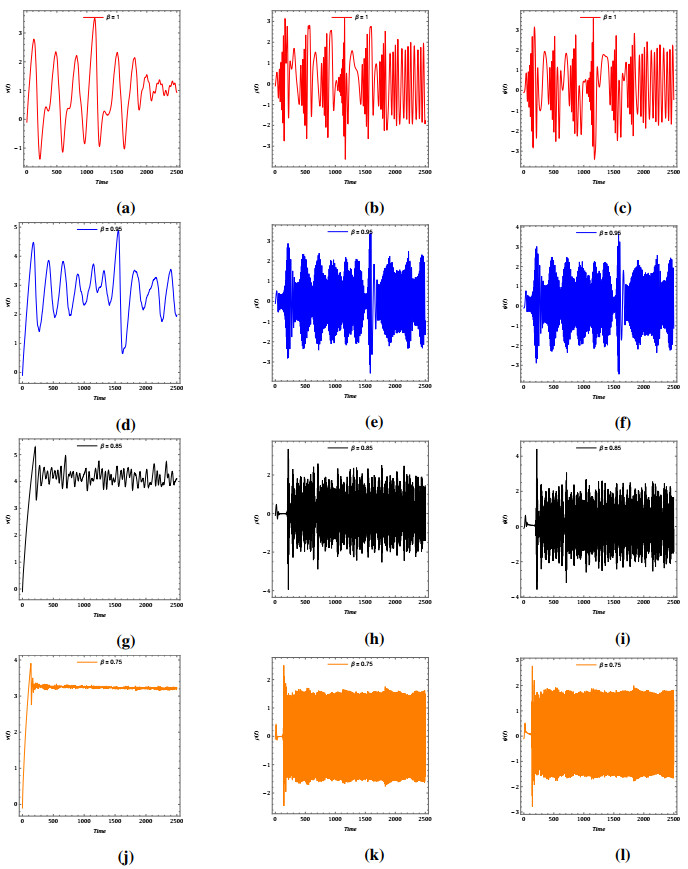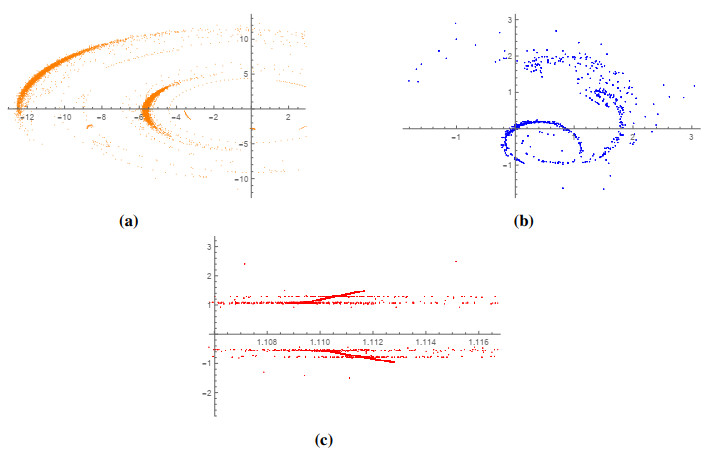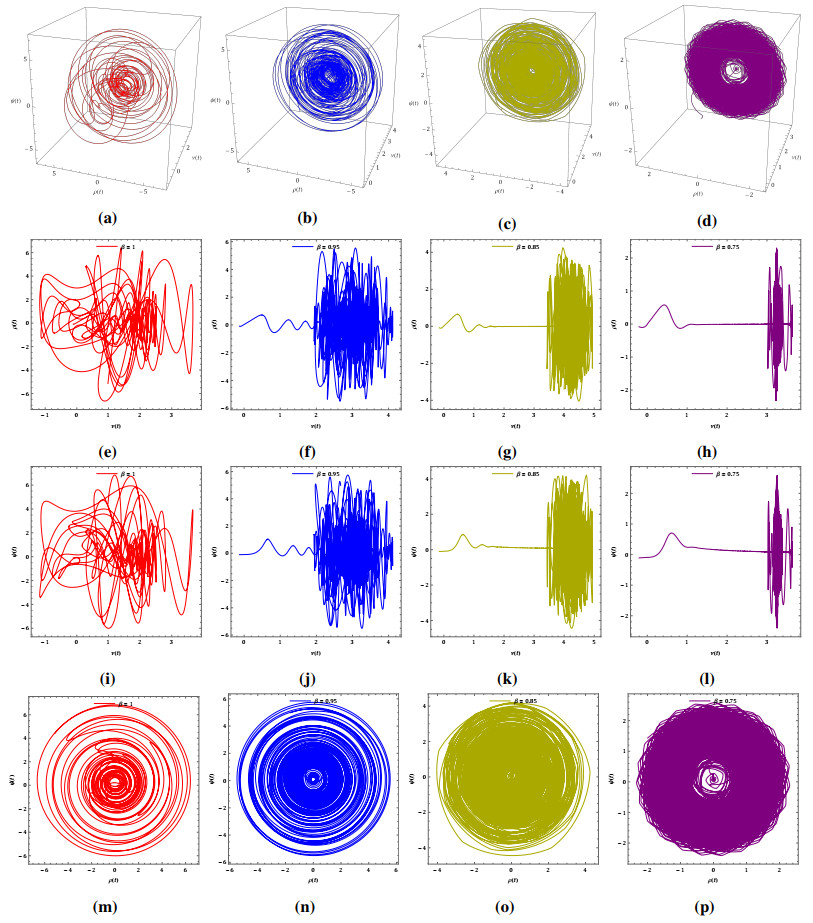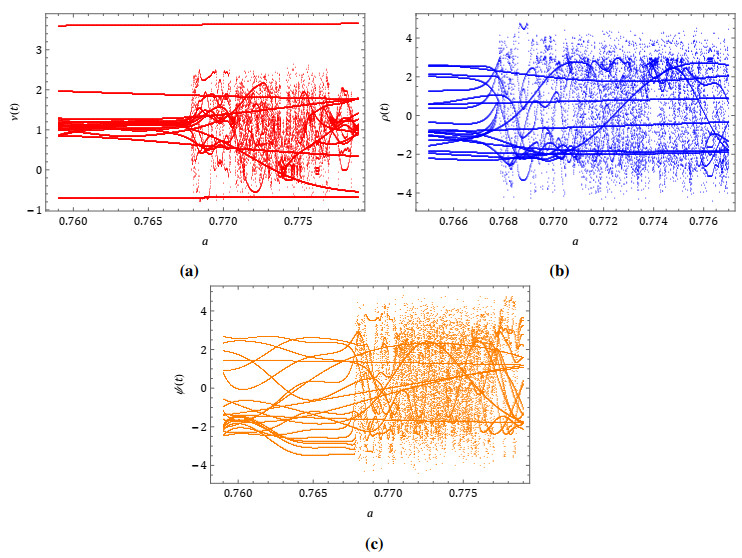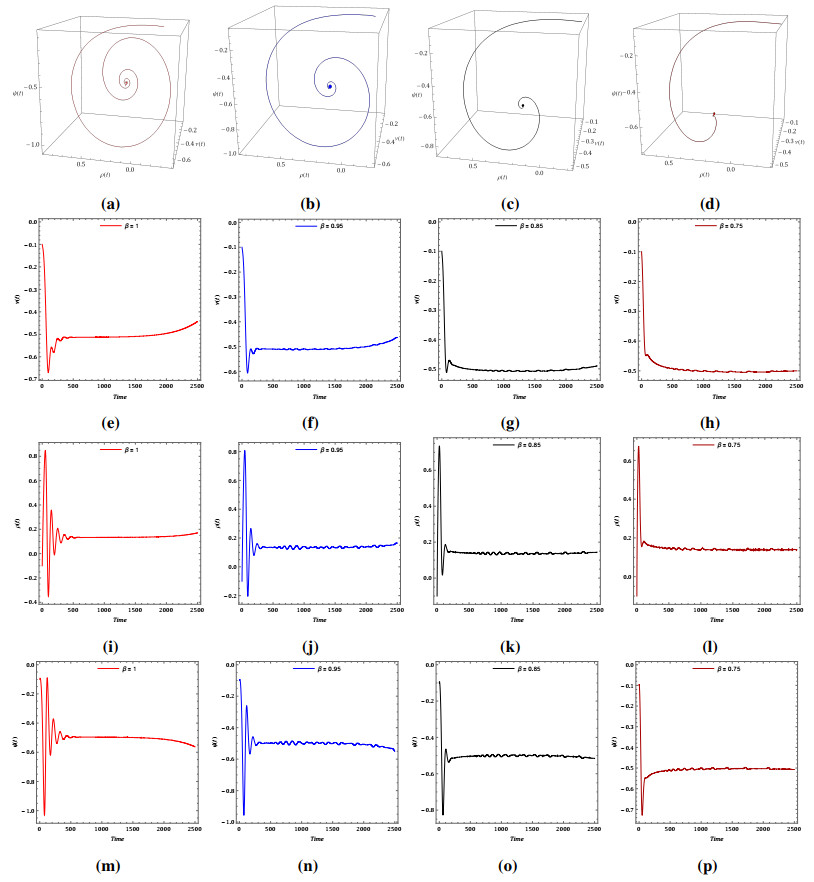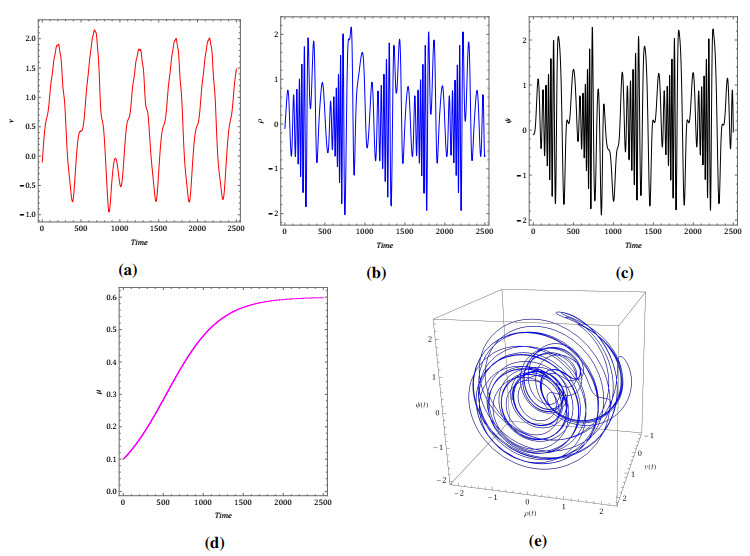1.
Introduction
Fractional calculus is a branch of mathematical analysis that generalizes integration and differentiation to arbitrary orders. Its origins can be traced back to the speculations of G. W. Leibniz in 1695 and L. Euler in 1730. Despite a long history, fractional calculus and the corresponding fractional differential equations (FDEs) are only gaining attention and popularity now. Different definitions of fractional derivatives exist, such as Riemann-Liouville, Caputo, Grunwald-Letnikov, Weyl, Marchaud, and Prabhakar. The history of this topic is available in [1,2,3]. Fractional calculus has several practical applications in various functional sciences, engineering, and technology fields. These include economics [4], chaotic systems [5], viscoelastic materials dynamics [6], electrochemical processes [7], traffic models in fluid dynamics [8], and optics [9]. Fractional derivatives are also helpful in describing the history profile and heritable properties of various constituents and practices. Furthermore, several researchers have investigated the existence and uniqueness of solutions for FDEs [2,3]. Additionally, because most fractional differential equations lack exact analytical solutions, approximate and numerical techniques, including semi-analytical methods, are widely employed to address fractional differential models. These methods include the homotopy analysis method [10], the variational iteration technique [11], Adams methods [12], Multi-Step Methods [13], Haar wavelet method [14], as well as several others [15,16,17,18].
The Adomian decomposition method (ADM) [19] has seen extensive use over the past decades in solving a broad range of different types of equations. Originally introduced by George Adomian in the 1980s, the method has experienced numerous developments, modifications, and improvements. For further details regarding the convergence and stability of the ADM in its application to different types of equations, see [20,21,22,23]. The extended review by Duan et al. [24] covers the method and its applications to fractional differential equations; see also [25,26].
In recent times, ADM has been extensively used to provide analytical approximate solutions for linear and nonlinear fractional differential equations [27,28,29]. The ADM has been improved in several ways to enhance its accuracy, speed, and computational efficiency. These modifications have also made it adaptable to different types of functional equations. The upgraded ADM has shown significant progress by rapidly converging to a series solution compared to the standard ADM. It has also proven to be computationally efficient in various models, which is crucial for researchers in applied science [30,31,32]. Modifications to the ADM have produced notable results and offer flexibility in solving complex higher-order equations. However, in specific cases, explicitly solving definite integrals with parameters in the domain, or even performing approximate numerical integrations for specific right-hand terms, is not possible. As a result, it becomes essential to approximate these right-hand terms using series expansions before applying the ADM. Orthogonal functions are highly esteemed in areas such as numerical methods and approximation theory.
However, in relation to their practical applications. Wazwaz et al. were the first to propose approximating right-hand terms using the Taylor series before applying the ADM [33]. Later, Hosseini [34] introduced the combination of ADM with the first kind of Chebyshev polynomials, demonstrating the effectiveness and reliability of this method for both linear and nonlinear equations. Following this, Liu [35] incorporated Legendre polynomials into the ADM and conducted a comparative analysis with the previously used Chebyshev polynomials. Furthermore, in [36], it was observed that using the second kind of Chebyshev polynomials with the ADM improved estimation accuracy, outperforming the first kind. Another approach for approximating right-hand terms, as suggested in [37], is through Gegenbauer and Jacobi polynomials. Finally, in [38], a study comparing Chebyshev, Legendre, and Laguerre polynomials found that Legendre polynomials were superior estimators to Chebyshev polynomials, contradicting earlier findings.
The present manuscript proposes several modification procedures for the standard ADM aimed at solving initial-value problems of fractional order. These procedures leverage the application of orthogonal polynomials, which play a crucial role in approximation theories. Specifically, we will explore the use of Legendre polynomials and Chebyshev polynomials of both the first and second kinds to develop enhanced modification methods for the standard ADM. Additionally, a comparative analysis will be conducted to evaluate the accuracy and efficiency of the proposed approach. The primary advantage of the proposed modification lies in its high level of accuracy, along with fewer computational steps and reduced complexity in the calculations.
The organization of the manuscript is as follows: Section 2 recalls some basics on fractional calculus and formulation and basic features of the Taylor series and orthogonal polynomials, Section 3 outlines the modified approaches to the fractional differential equations, Section 4 applies the constructed scheme on certain test models, while Section 5 presents some concluding notes.
2.
Main concepts and theorems
In the current section, we present some definitions and properties of the fractional calculus. Further, we discuss the formulation and basic features of the Taylor series and orthogonal polynomials.
2.1. Basic definitions and properties of the fractional calculus
Definition 2.1. For a function y(x)∈C([a,b]) and a<x<b, the Riemann-Liouville fractional integral operator of order α>0 is defined as [1,2]
Note from the above that for α=0, we have I0ay(x)=y(x), which is the identity operator. Additionally, when α∈N, then Iαay(x) coincides with that classical integral.
Definition 2.2. For y(x)∈C([a,b]), the Caputo fractional derivative of order α>0 is defined by [1,2]
In the following, we will outline some important properties for the fractional differential and integral operators based on the aforementioned definitions [1,2].
i)
ii)
where m−1<α≤m.
iii)
where m−1<α≤m, n>−1.
iv)
v).
In this study, we are solving fractional differential equations in the Caputo sense. We have chosen the Caputo definition to solve the fractional differential equations because it allows us to obtain a unique and exact solution by specifying additional initial conditions for the fractional equation. The Caputo definition is widely accepted as it enables defining initial conditions related to the integer derivatives of the derived functions in the considered models. It is worth noting that many studies have extensively explored the geometric interpretation of fractional derivatives.
2.2. The structure and fundamental characteristics of the Taylor series and orthogonal polynomials
In this study, we focus on the function g(x), referred to as the "source term". Our goal is to approximate this term using various methods to reduce computational complexity and simplify the solution process. The significance of orthogonal functions in estimation theory and numerical methods is well known. Therefore, these functions and polynomials are utilized in this study to further enhance the accuracy of the standard Adomian decomposition method (ADM). We begin by applying the Taylor series expansion to the source term g(x), for an arbitrary positive integer l, as follows:
Thus, in the subsequent sections, we have developed a series of Adomian modification methods using orthogonal polynomials. In particular, we employed orthogonal polynomials such as Legendre and the first and second kinds of Chebyshev polynomials.
(1) Chebyshev's polynomials of the first kind
The first kind of Chebyshev polynomial Tk(x) expanding g(x) is
where
and
(2) Chebyshev's polynomials of the second kind
Similarly, we employ Chebyshev polynomials of the second kind to approximate the source term g(x), rather than using Chebyshev polynomials of the first kind, as shown below:
where
and
Finally, to introduce a modification method utilizing Legendre polynomials, we represent the source term g(x) as a series expansion of Legendre polynomials as follows.
(3) Legendre's polynomials
where
and
3.
Modified Adomian decomposition method
This section introduces modified Adomian decomposition methods with some orthogonal polynomials for addressing initial-value problems (IVPs) of nonhomogeneous fractional differential equations.
We consider the initial-value problem (IVP) for a nonlinear fractional differential equation as shown below:
In the above equation, y(x) is the unknown function, Dα∗ is the Caputo fractional derivative operator of high order α, which is easily invertible, N is the nonlinear operator, R is the remaining linear operator, which might include other Caputo fractional derivative operators Dv∗ (v<α), and g is the given source function.
To solve the above initial-value problem (IVP), the approach involves applying the operator Iα on both sides of (3.1), which is indeed the inverse operator of Dα∗, and further make use of (2.4) to obtain
Alternatively, by expressing the latter equation in accordance with the Adomian decomposition method, we arrive at the following formulation:
where the An's are the Adomian polynomials, which are to be computed using the following compacted formula:
The recurrence relation for y(x) can be established by simply defining:
This approach follows the structure outlined below, resulting in the corresponding recursive solution.
(1) Modification method via Taylor's series
(2) Modification method via the first kind of Chebyshev's polynomials
(3) Modification method via the seconed kind of Chebyshev's polynomials
(4) Modification method via Legendre's polynomials
Considering the rapid convergence of the decomposition series, it will be demonstrated through a representative example that only a small number of terms are needed to achieve an accurate solution. Subsequently, a comparison will be made between the approximate y(x) and those derived from Taylor expansion, Chebyshev expansion, and Legendre expansion. This comparison aims to validate both the accuracy of the obtained solution and the efficacy of the proposed method.
4.
Numerical applications
This section makes use of some test IVPs to ascertain the effectiveness of the proposed recursive schemes numerically for the classes of the fractional differential equations. All calculations are performed, and the plots are generated by using Maple 22 with 8 digits precision.
Example 4.1. Consider the following inhomogeneous fractional differential equation [39]:
The exact solution of the above problem when α=1 is
In the above equation, y(x) is the unknown function, Dα∗ is the Caputo fractional derivative operator of high order α, and g(x)=sin(x).
To solve the above IVP, we apply the operator Iα to both sides of the IVP to get:
Applying the standard Adomian decomposition method yields the following result:
The recurrence relation for y(x) can be established by simply defining:
It is essential to implement the suggested modifications while dealing with the complex source term associated with the sin(x) term in computations. It is important to recognize that directly applying the ADM has certain disadvantages, such as a large computation size, extended computation time, and complicated computation of the remaining terms since it relies on the first term. Considering the preceding discussion, we propose the following formulations to relieve these issues.
● The expansion of g(x)=sin(x) using the Taylor series l=6 is
such that upon summing the above components yields the following series solution:
● The expansion of g(x)=sin(x) using the first kind of Chebyshev polynomials l=6 is
such that their summation results in
● The expansion of g(x)=sin(x) using the second kind of Chebyshev polynomials l=6 is
which results in the subsequent series solution:
● The expansion of g(x)=sin(x) using Legendre polynomials l=6 is
that sums to the following:
Additionally, in the following Table 1, we present an analysis of the simulated error difference for the orthogonal polynomial with n=5, compared to the exact solution of the problem with α=1. In addition, we have visually represented the obtained solution for the IVP in the Figure 1(a)–(e), showcasing the graphical visualization for various values of α.
Example 4.2. Let us make consideration of the nonlinear inhomogeneous fractional IVP as follows [40]:
The exact solution of the above problem when α=2 is
In the above equation, y(x) is the unknown function, Dα∗ is the Caputo fractional derivative operator of high order α, y3(x) is a nonlinear term, and g(x)=sin(x)cos2(x).
To solve the above IVP, we apply the operator Iα to both sides of the IVP to get:
Applying the standard Adomian decomposition method yields the following result:
where An are the Adomian polynomials for nonlinear term y3(x) which when computed iteratively takes the following form:
The recurrence relation for y(x) can be established by simply defining:
To simplify the complexity of g(x)=sin(x)cos2(x), we recommend using the following formulations:
● The expansion of g(x)=sin(x)cos2(x) using the Taylor series l=6 is
leading to the following series solution:
● The expansion of g(x)=sin(x)cos2(x) using the first kind of Chebyshev polynomials l=6 is
that sums to the following:
● The expansion of g(x)=sin(x)cos2(x) using the second kind of Chebyshev polynomials l=6 is
that leads to the following series solution:
● The expansion of g(x)=sin(x)cos2(x) using Legendre polynomials l=6 is
which totals to the following:
In the following Table 2, we present an analysis of the simulated error difference for the orthogonal polynomial with n=5, compared to the exact solution of the problem with α=2. Further, we graphically visualize the obtained solution for the IVP in Figure 2(a)–(e), showcasing the various visualizations for different values of α.
Based on the provided illustration and the outcomes obtained through analyses and comparisons, we can conclude that incorporating orthogonal polynomials such as Chebyshev, Legendre, and Taylor series can significantly enhance the performance of the ADM. Comparison between the standard ADM and Taylor series with Legendre and Chebyshev polynomials shows that the latter provide more accurate estimations.
4.1. Special application
Consider the fractional order forced Duffing-van der Pol oscillator equation as follows
● (Single-well a>0,b>0). a=b=0.5, μ=0.1, f=0.5, and ω=0.79.
● (Double-well a<0,b>0). a=−0.5,b=0.5, μ=0.1, f=0.5, and ω=0.79.
● (Double-hump a>0,b<0). a=0.5,b=−0.5, μ=0.1, f=0.5, and ω=0.79.
To solve Eq (4.30) using the modification method of the ADM, we apply the previously outlined algorithm as follows:
such that when the ADM is deployed reveals
where An and Bn are Adomian polynomials corresponding to the nonlinear terms y2(x)y′(x) and y3(x) respectively, defined as follows:
Moreover, the formal recursive relationship for the governing fractional IVP is obtained as follows:
In the subsequent discussion, to avoid the complexity of calculating the source term fcos(ωx), we will apply the proposed modification methods to solve the governing equation of the forced Duffing-van der Pol oscillator. We will first introduce the classical Taylor series approach, followed by the proposed schemes. The solution will be represented based on the respective modifications as follows: yTaylor(x) for the Taylor series expansion, yP(x) for the Legendre series expansion, and yT(x) and yU(x) for the first and second kind of Chebyshev series expansion.
4.1.1. Single-well situation
The recursive formula for the fractional problem (4.30) in this case is given by:
● Modification method via Taylor's series
The source term g(x)=12cos(0.79x) will be expanded for l=6 in the following manner:
This yields the subsequent iterative components.
such that upon summing the above components yields the following series solution:
● Modification method via Chebyshev's polynomials of the first kind
We Proceed by expanding the source term g(x) in the following manner:
Therefore, the solution components are as follows:
which results in the subsequent series solution:
● Modification method via Chebyshev's polynomials of the second kind
We begins by expressing the source term g(x) in the following manner:
This gives the following iterative solutions:
that sums to the following:
● Modification method via Legendre's polynomials
Now, the expansion of the source term g(x) using Legendre polynomials gives:
This gives the following iterative solutions:
that sums to the following:
4.1.2. Double-well situation
The recursive formula for the fractional problem (4.30) in this case is given by:
Therefore, without further details, we provide the corresponding solution by applying the proposed modification methods for l=6, following the same procedure as in the single-well situation, as outlined below.
4.1.3. Double-hump situation
The recursive formula for the fractional problem (4.30) in this case is given by:
Furthermore, without loss of generality, using the same approach as in the above situations, we present the corresponding solutions by applying the proposed modification methods for l=6.
The results obtained using the modification method of the ADM with l=6 for three different scenarios (single-well, double-well, and double-hump) are presented in Tables 4, 6, and 8, respectively. In this analysis, we set the fractional order of the problem to α=2. The numerical results are compared with those from the variational iteration method (VIM) [41], the ultraspherical wavelets method (UWM) [42], the fourth-order Runge-Kutta (RK) method, and Bernoulli wavelet method (BWM) [43], see Tables 3, 5, and 7, respectively. In addition, CPU times of the presented method are listed in Tables 4, 6, and 8. Figure 3 shows the obtained numerical solutions by the presented modification method of the ADM.
5.
Conclusions
This study investigates the application of the Taylor series, Legendre polynomials, and both the first and second kinds of Chebyshev polynomials within the Adomian decomposition method (ADM) for solving initial-value problems (IVPs) of fractional differential equations. The findings demonstrate the efficiency and accuracy of these approaches. Additionally, the study presents several modification methods for the ADM, highlighting the critical role of orthogonal polynomials in numerical analysis. Among the nonlinear inhomogeneous IVPs tested, the Legendre polynomial methods exhibited the lowest error rates. Given their computational benefits, these methods are recommended for fractional-order IVP models in scientific and engineering applications. Furthermore, the results obtained can be extended or generalized to various types of fractional differential equations and their associated operators.
Author contributions
Mariam Al-Mazmumy: Conceptualization, methodology, investigation, software, writing review & editing; Maryam Ahmed Alyami: Methodology, investigation, writing review & editing; Mona Alsulami: Methodology, investigation, writing review & editing; Asrar Saleh Alsulami: Formal analysis, methodology, investigation, writing original draft preparation, software, writing review & editing; Saleh S. Redhwan: Writing review & editing. All authors have read and approved the final version of the manuscript for publication.
Acknowledgments
The authors would like to thank the editor and referees for their comments and suggestions, which improved the presentation of the original manuscript.
Conflict of interest
The authors declare that they have no conflict of interest.









 DownLoad:
DownLoad:





